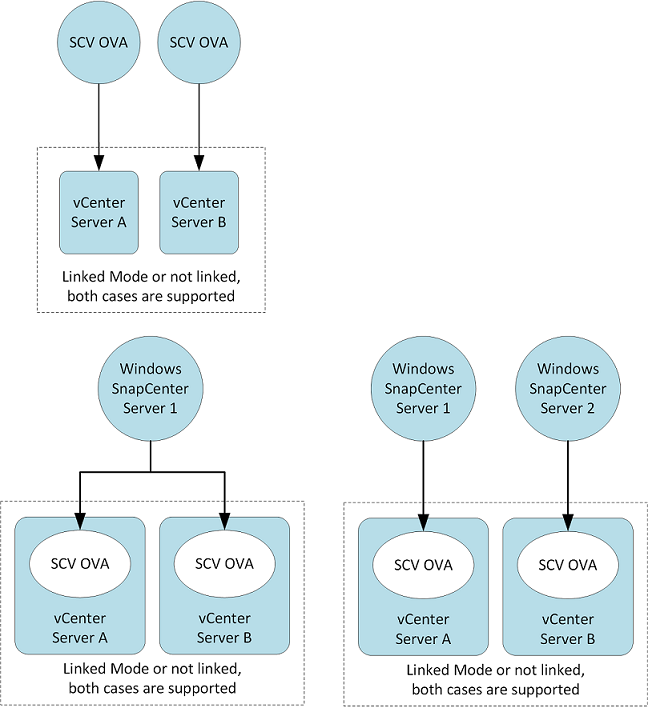Deployment planning and requirements
 Suggest changes
Suggest changes


You should be aware of the deployment requirements before you deploy the virtual appliance. The deployment requirements are listed in the following five tables.
Host requirements
Before you begin deployment of SnapCenter Plug-in for VMware vSphere, you should be familiar with the host requirements.
-
You must deploy the SnapCenter VMware plug-in as a Linux VM.
The SnapCenter VMware plug-in is deployed as a Linux VM regardless of whether you use the plug-in to protect data on Windows systems or Linux systems.
-
You should deploy the SnapCenter VMware plug-in on the vCenter Server.
Backup schedules are executed in the time zone in which the SnapCenter VMware plug-in is deployed. vCenter reports data in the time zone in which the vCenter is located. Therefore, if the SnapCenter VMware plug-in and vCenter are in different time zones, data in the SnapCenter VMware plug-in Dashboard might not be the same as the data in the reports.
-
You must not deploy the SnapCenter VMware plug-in in a folder that has a name with special characters.
The folder name should not contain the following special characters: $!@#%^&()_+{}';.,*?"<>|
-
You must deploy and register a separate, unique instance of the SnapCenter VMware plug-in for each vCenter Server.
-
Each vCenter Server, whether or not it is in Linked Mode, must be paired with a separate instance of the SnapCenter VMware plug-in.
-
Each instance of the SnapCenter VMware plug-in must be deployed as a separate Linux VM.
For example, if you want to perform backups from six different instances of the vCenter Server, then you must deploy the SnapCenter VMware plug-in on six hosts and each vCenter Server must be paired with a unique instance of the SnapCenter VMware plug-in.
-
-
To protect vVol VMs (VMs on VMware vVol datastores), you must first deploy ONTAP Tools for VMware vSphere. ONTAP Tools provisions and configures storage for vVols on ONTAP and on the VMware web client.
For more information, see ONTAP Tools for VMware vSphere
For the latest information about supported versions of ONTAP Tools, see the NetApp Interoperability Matrix Tool.
-
The SnapCenter VMware plug-in provides limited support of shared PCI or PCIe devices (for example, NVIDIA Grid GPU) due to a limitation of the virtual machines in supporting Storage vMotion. For more information, see the vendor's document Deployment Guide for VMware.
-
What is supported:
Creating resource groups
Creating backups without VM consistency
Restoring a complete VM when all the VMDKs are on an NFS datastore and the plug-in does not need to use Storage vMotion
Attaching and detaching VMDKs
Mounting and unmounting datastores
Guest file restores
-
What is not supported:
Creating backups with VM consistency
Restoring a complete VM when one or more VMDKs are on a VMFS datastore.
-
-
For a detailed list of the SnapCenter VMware plug-in limitations, see the SnapCenter Plug-in for VMware vSphere Release Notes.
License requirements
| You must provide licenses for… | License requirement |
|---|---|
ONTAP |
One of these: SnapMirror or SnapVault (for secondary data protection regardless of the type of relationship) |
Additional products |
vSphere Standard, Enterprise, or Enterprise Plus |
Primary destinations |
SnapCenter Standard: required to perform application-based protection over VMware |
Secondary destinations |
SnapCenter Standard: used for failover operations for application-based protection over VMware |
Software support
| Item | Supported versions |
|---|---|
vCenter vSphere |
HTML5 client: 6.5U2/U3, 6.7x, 7.0, 7.0U1, 7.0U2, 7.0U3 |
ESXi |
6.5U2 and later |
IP addresses |
IPv4, IPv6 |
VMware TLS |
1.2, 1.3 |
TLS on the SnapCenter Server |
1.2, 1.3 |
VMware application vStorage API for Array Integration (VAAI) |
SnapCenter Plug-in for VMware vSphere uses this to improve performance for restore operations. It also improves performance in NFS environments. |
ONTAP Tools for VMware |
SnapCenter Plug-in for VMware vSphere uses this to manage vVol datastores (VMware virtual volumes). For supported versions, see the NetApp Interoperability Matrix Tool. |
For the latest information about supported versions, see the NetApp Interoperability Matrix Tool.
Space and sizing requirements
| Item | Requirements |
|---|---|
Operating system |
Linux |
Minimum CPU count |
4 cores |
Minimum RAM |
Minimum: 12 GB |
Minimum hard drive space for the SnapCenter Plug-in for VMware vSphere, logs, and MySQL database |
100 GB |
Connection and port requirements
| Type of port | Preconfigured port |
|---|---|
VMware ESXi Server port |
443 (HTTPS), bidirectional |
SnapCenter Plug-in for VMware vSphere port |
8144 (HTTPS), bidirectional Note: You cannot modify the port configuration. |
VMware vSphere vCenter Server port |
You must use port 443 if you are protecting vVol VMs. |
Storage cluster or storage VM port |
443 (HTTPS), bidirectional |
Configurations supported
Each plug-in instance supports only one vCenter Server. vCenters in linked mode are supported. Multiple plug-in instances can support the same SnapCenter Server as shown in the following figure.

RBAC privileges required
The vCenter administrator account must have the required vCenter privileges, as listed in the following table.
| To do this operation… | You must have these vCenter privileges… |
|---|---|
Deploy and register the SnapCenter Plug-in for VMware vSphere in vCenter |
Extension: Register extension |
Upgrade or remove the SnapCenter Plug-in for VMware vSphere |
Extension
|
Allow the vCenter Credential user account registered in SnapCenter to validate user access to the SnapCenter Plug-in for VMware vSphere |
sessions.validate.session |
Allow users to access the SnapCenter Plug-in for VMware vSphere |
SCV Administrator |
AutoSupport
The SnapCenter Plug-in for VMware vSphere provides a minimum of information for tracking its usage, including the plug-in URL. AutoSupport includes a table of installed plug-ins that is displayed by the AutoSupport viewer.


